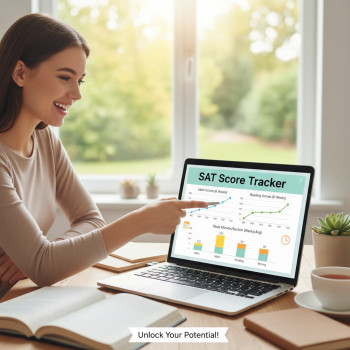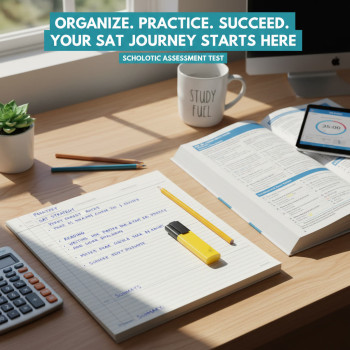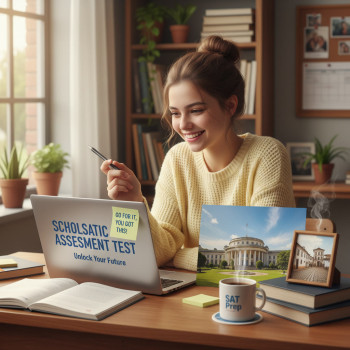Why the Digital SAT Changes How You Learn (and why that’s a good thing)
Think of the Digital SAT as the same exam you’ve heard about—same purpose, same colleges caring about your score—but wearing a different outfit. It’s shorter, delivered on a device through the Bluebook app, and uses adaptive testing in a way that rewards smart practice more directly. Those differences mean your old study habits (endless passive reading, frantic last-minute content dumps) won’t serve you as well. The good news? With a few intentional shifts—some mindset work, a couple of tech-savvy habits, and study strategies tuned to an adaptive format—you can prepare more efficiently, with less stress and better results.
Step 1: Understand Your Learning Style—and What Needs to Change
Before rearranging your schedule or buying more books, take a minute to understand how you learn best. Do you retain ideas by doing practice problems? By talking through concepts with a peer? By writing and summarizing? The Digital SAT favors students who can apply skills quickly and accurately, so knowing how you learn helps you choose the right practice methods.
Learning styles that thrive with the Digital SAT
- Active practitioners: If hands-on practice is your strength, you’ll benefit from frequent, timed Bluebook practice tests and targeted question banks.
- Analytical thinkers: If you learn by breaking problems into smaller pieces, practice deconstructing adaptive items—identify why an answer is correct and why the others are tempting.
- Social learners: If you learn best in conversation, regularly explain tricky problems to a study buddy or tutor; teaching is one of the fastest ways to cement understanding.
- Reflective learners: If you learn by reflection, keep a short “mistake log” after each practice session and review it weekly to detect patterns.
What to stop doing
- Endless passive review—highlighting without doing—because the Digital SAT tests application under time pressure.
- Ignoring device familiarity—if you only practice on paper but test digitally, you’ll lose time navigating the interface.
- Skipping error analysis—simply redoing problems without understanding mistakes wastes effort in an adaptive environment.
Step 2: Make Practice Digital—Intentionally
Practicing digitally is non-negotiable. That doesn’t just mean taking practice tests on a screen; it means replicating test-day conditions, learning the Bluebook tools, and getting comfortable with question navigation and on-screen calculators. That comfort saves cognitive energy on test day, which you can then spend on reasoning.
How to structure digital practice sessions
- Start with short, focused sessions: 30–45 minutes of active practice on one skill (e.g., algebraic manipulation or evidence-based reading).
- Take regular Bluebook full-length practice tests under timed conditions. Treat them like dress rehearsals—same device, same environment, same breaks.
- Use the test preview to familiarize yourself with the tools (flagging questions, navigating passages, using the on-screen calculator).
Step 3: Blend Content Mastery with Strategy
Content knowledge matters—vocabulary, algebra, grammar rules—but so does strategy. The Digital SAT’s adaptive nature rewards getting the right balance between speed and accuracy. Train both.
Content-first: where to invest time
- Math fundamentals: linear equations, systems, ratios, functions, basic statistics, and how to interpret graphs. These are the backbone of many questions.
- Evidence-based reading and writing: practice identifying author intent, evidence support, and grammatical logic rather than memorizing obscure rules.
- Command of core vocabulary: rather than long word lists, focus on words in context—how meaning shifts with author tone and sentence structure.
Strategy-first: habits that win points
- Prioritize questions: in each section, aim to secure the score you can confidently reach first, then consider higher-difficulty items.
- Use the flagging system: mark questions to return to so you don’t waste time oscillating between choices.
- Estimate before calculating: on some math items a quick estimate will tell you whether a computed answer is reasonable.
Step 4: Make Your Study Plan Fit Your Brain (Not the Other Way Around)
Generic schedules rarely stick. Build a plan that fits your attention span, school schedule, and peak energy times. The goal is consistent, deliberate practice—small wins every day add up faster than marathon cramming.
Weekly rhythm example
Here’s a sample structure you can adapt. Substitute topics to match your needs.
| Day | Focus | Session Type | Time |
|---|---|---|---|
| Monday | Algebra practice | Targeted drills + 30 min review | 45–60 min |
| Tuesday | Reading passages | Passage work + explanation practice | 45–60 min |
| Wednesday | Grammar and style | Timed sections + error log | 45 min |
| Thursday | Math problem solving | Mixed problem set + review | 60 min |
| Friday | Practice test blocks | One or two timed blocks (digital) | 60–90 min |
| Weekend | Full-length practice / rest | Full Bluebook practice test every 2–3 weeks | 3–4 hrs (occasionally) |
Notice we interleave skill practice and test simulation. That combination trains both the mental muscles and the test-taking routine.
Step 5: Turn Mistakes into a Roadmap
In adaptive testing, each answer helps shape the next question you receive. The smartest learners mine mistakes for patterns and treat every wrong answer as useful feedback. Don’t just correct—analyze.
How to analyze mistakes effectively
- Record the mistake: note the question type, the trap you fell into, and whether it was content, carelessness, or timing-related.
- Categorize: create simple categories—Concept, Calculation, Interpretation, Time/Stress—and tally how often each occurs.
- Plan a fix: for concept errors, schedule targeted lessons; for careless mistakes, practice under timed pressure and reduce distractions; for time issues, work on pacing strategies.
Short error log template
- Question ID / page
- Type (Algebra/Passage/GRE-style grammar)
- Mistake reason
- Fix action (drill, review concept, practice pacing)
Step 6: Practice with Purpose—The Right Mix of Blocks and Micro-Practice
Block practice (full sections) builds stamina and pacing; micro-practice (10–20 minute focused drills) builds specific skills. Use both.
Examples of micro-practice
- 10-minute speed drills: 5 reading questions under 10 minutes to sharpen skimming and inference skills.
- Focused math sets: 15 minutes on function interpretation problems, then immediate review.
- Grammar mini-sprints: 12–15 sentence corrections with explanation practice.
When to simulate full sections
Simulate full sections once or twice a week as you get closer to test day, increasing to a full, timed practice test every one to two weeks during the final month. These sessions should mirror testing conditions: device, environment, and breaks. If you can, practice on the same model of device you’ll use on test day, or at least the same operating system.
Step 7: Build Resilience—Test-Day Skills That Aren’t Academic
Adapting to the Digital SAT isn’t only about content. The platform introduces small friction points that can throw you off: unfamiliar navigation, screen fatigue, and the psychological effect of seeing an adaptive jump in difficulty. Learn the non-academic skills that keep you calm and focused.
Practical test-day habits
- Device readiness: charge your device, close background apps, and disable notifications before testing.
- Micro-break strategies: use allowed breaks to stand, stretch, and reset your breathing.
- Anchor rituals: a brief mindful routine (e.g., three deep breaths before each section) helps reduce adrenaline spikes that cause careless errors.
Step 8: Use Technology as a Tutor, Not a Crutch
Digital tools like Bluebook and online practice resources are powerful, but they’re not magic. Pair them with thoughtful reflection: after each digital block, ask what changed about your thinking and what you’ll do differently next time. That reflection is where progress compounds.
When a human touch helps: Sparkl’s personalized tutoring
There are moments when guided human feedback accelerates learning—especially when patterns in your mistakes aren’t obvious. Personalized tutoring (for example, Sparkl’s 1-on-1 guidance and tailored study plans) can diagnose blind spots quickly, offer targeted practice, and provide AI-driven insights to track progress. Consider bringing in expert help if you’ve plateaued despite consistent practice.
Step 9: Adapt Study Habits to Energy and Schedule
High-quality practice depends on when and how you study. Align sessions with your natural energy peaks, and protect those times from distraction. If you’re a morning person, do your focused math practice early. If your concentration is better after school, reserve that slot for reading and writing.
Practical tips for busy students
- Split long sessions into focused micro-sessions if school or activities block long uninterrupted time.
- Keep a lightweight checklist of daily priorities—1 skill practice + 1 timed block + 1 quick review.
- Use short review windows (10–15 minutes) during transit or between classes to reinforce vocabulary or formulas.
Step 10: Measure Progress with Smart Metrics
Not all practice gains show up as a higher practice-test score right away. Track metrics that reflect learning, not just momentary performance.
Metrics worth tracking
- Accuracy by question type (e.g., algebra, data analysis, command of evidence).
- Time per question range: how often do you finish with extra time vs. rushing?
- Mistake categories and frequency over time.
- Stamina: how performance holds across later sections in a full test.
Real-World Examples: Small Tweaks, Big Gains
Here are a couple of short case studies that show how adapting your style can produce measurable gains.
Case study 1: Maya—From scattered studying to strategic practice
Maya had been studying by re-reading notes and doing occasional practice problems. After shifting to short daily micro-practice sessions, using the Bluebook previews to master tools, and keeping an error log, she cut careless mistakes in half and improved pacing. The combination of focused digital practice and error analysis produced a more confident test-day performance.
Case study 2: Jamal—Turning anxiety into a routine
Jamal froze on harder questions, which affected his performance downstream. He practiced mindfulness anchors (simple breathing), learned to flag and move on, and used targeted high-difficulty practice to normalize challenging items. His skyrocketing calm led to fewer wasted minutes and a higher score band.
Sample Weekly Plan: A 6-Week Push
Below is a compact, adaptable 6-week schedule for students with school commitments. Mix and match based on weaknesses and test date.
| Week | Primary Focus | Weekly Goal |
|---|---|---|
| 1 | Baseline + device familiarization | Take a Bluebook practice test; create an error log |
| 2 | Math fundamentals | Drill weak algebraic and function areas; 2 timed blocks |
| 3 | Reading and evidence | Practice passage strategies and inference work; 2 timed blocks |
| 4 | Grammar and mixed practice | Reduce grammar mistakes; mixed question sets + one full test |
| 5 | Adaptive test strategy | Simulate adaptive practice tests; refine pacing |
| 6 | Polish & taper | Final practice tests, rest strategies, and logistical prep |
When to Bring in Extra Help
Some plateaus respond quickly to a new perspective. If you’re studying consistently but not improving, consider one-on-one tutoring. Personalized tutors—such as those at Sparkl—can create tailored study plans, give focused feedback on consistent error patterns, and help prioritize high-impact practice. A short tutoring sprint often unlocks progress faster than adding more hours of the same self-study routine.
Final Checklist: Test-Ready Habits
- Practice on a device similar to your test device and use Bluebook regularly.
- Keep an error log and act on it—don’t let mistakes pile up unnoticed.
- Mix micro-practice with full digital simulations to build skill and stamina.
- Practice pacing with flagging and return strategies to maximize adaptive advantage.
- Manage non-academic factors: sleep, nutrition, and small mindful routines before sections.
- If progress stalls, try a targeted tutoring sprint for personalized diagnosis.
Parting Thought: Small Adaptations, Big Confidence
The Digital SAT rewards thoughtful adaptation. It doesn’t require reinventing yourself as a learner—just nudging your strategies toward intentional digital practice, careful error analysis, and smart pacing. When you pair those habits with occasional expert guidance, like personalized tutoring and data-driven insights, you transform uncertainty into a manageable path forward. The journey to your best score is not a single sprint but many short, purposeful steps. Start with a practice test, learn from one mistake today, and build momentum from there—your improved approach will show up where it counts: on test day.
Ready to adapt?
Take one concrete step today: do a short, timed digital practice block and write down one recurring mistake. Fix that specific issue this week, and you’ll be surprised how quickly steady, targeted practice changes your outcomes. Good luck—you’re farther along than you think, and with the right habits, the Digital SAT becomes not an obstacle but another opportunity to show what you know.

















No Comments
Leave a comment Cancel